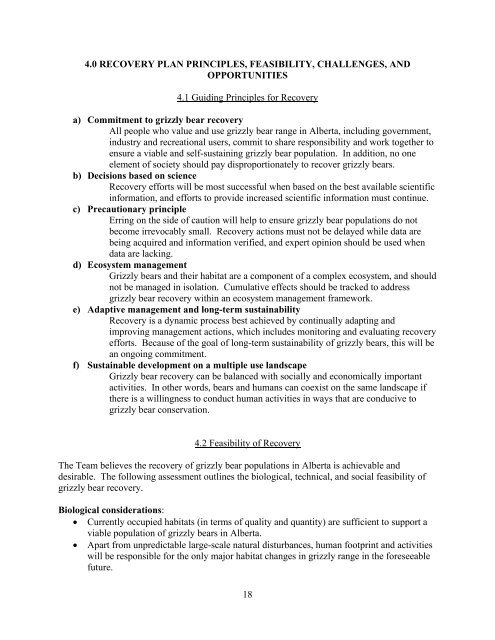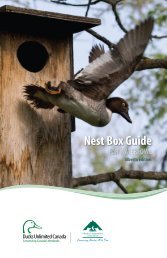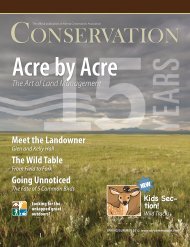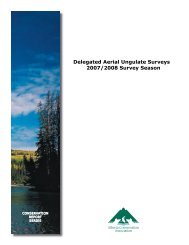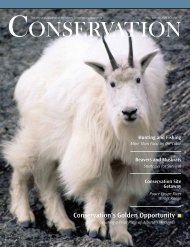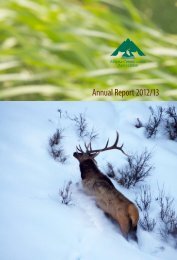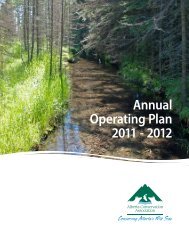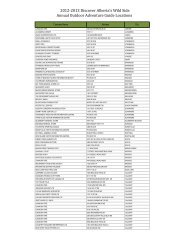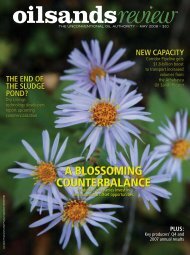Alberta Grizzly Bear Recovery Plan 2008-2013 - Alberta Sustainable ...
Alberta Grizzly Bear Recovery Plan 2008-2013 - Alberta Sustainable ...
Alberta Grizzly Bear Recovery Plan 2008-2013 - Alberta Sustainable ...
Create successful ePaper yourself
Turn your PDF publications into a flip-book with our unique Google optimized e-Paper software.
4.0 RECOVERY PLAN PRINCIPLES, FEASIBILITY, CHALLENGES, AND<br />
OPPORTUNITIES<br />
4.1 Guiding Principles for <strong>Recovery</strong><br />
a) Commitment to grizzly bear recovery<br />
All people who value and use grizzly bear range in <strong>Alberta</strong>, including government,<br />
industry and recreational users, commit to share responsibility and work together to<br />
ensure a viable and self-sustaining grizzly bear population. In addition, no one<br />
element of society should pay disproportionately to recover grizzly bears.<br />
b) Decisions based on science<br />
<strong>Recovery</strong> efforts will be most successful when based on the best available scientific<br />
information, and efforts to provide increased scientific information must continue.<br />
c) Precautionary principle<br />
Erring on the side of caution will help to ensure grizzly bear populations do not<br />
become irrevocably small. <strong>Recovery</strong> actions must not be delayed while data are<br />
being acquired and information verified, and expert opinion should be used when<br />
data are lacking.<br />
d) Ecosystem management<br />
<strong>Grizzly</strong> bears and their habitat are a component of a complex ecosystem, and should<br />
not be managed in isolation. Cumulative effects should be tracked to address<br />
grizzly bear recovery within an ecosystem management framework.<br />
e) Adaptive management and long-term sustainability<br />
<strong>Recovery</strong> is a dynamic process best achieved by continually adapting and<br />
improving management actions, which includes monitoring and evaluating recovery<br />
efforts. Because of the goal of long-term sustainability of grizzly bears, this will be<br />
an ongoing commitment.<br />
f) <strong>Sustainable</strong> development on a multiple use landscape<br />
<strong>Grizzly</strong> bear recovery can be balanced with socially and economically important<br />
activities. In other words, bears and humans can coexist on the same landscape if<br />
there is a willingness to conduct human activities in ways that are conducive to<br />
grizzly bear conservation.<br />
4.2 Feasibility of <strong>Recovery</strong><br />
The Team believes the recovery of grizzly bear populations in <strong>Alberta</strong> is achievable and<br />
desirable. The following assessment outlines the biological, technical, and social feasibility of<br />
grizzly bear recovery.<br />
Biological considerations:<br />
• Currently occupied habitats (in terms of quality and quantity) are sufficient to support a<br />
viable population of grizzly bears in <strong>Alberta</strong>.<br />
• Apart from unpredictable large-scale natural disturbances, human footprint and activities<br />
will be responsible for the only major habitat changes in grizzly range in the foreseeable<br />
future.<br />
18


